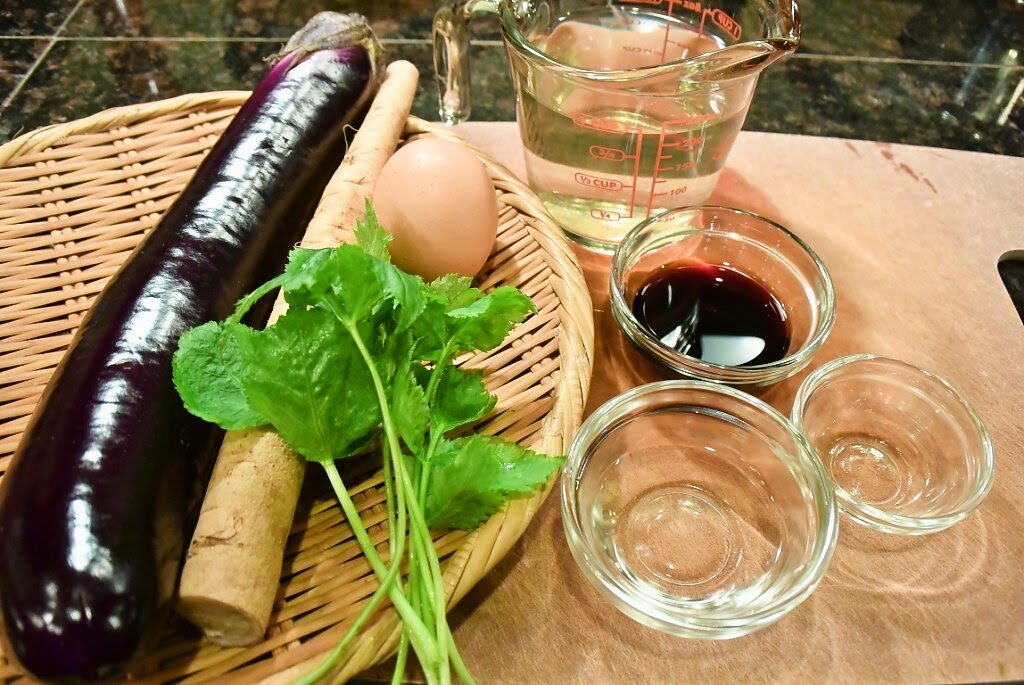Very satisfying! The creamy eggplant is a huge plus. As the eggplant is deep-fried, this is substantial enough to be served as a main dish. Good as is, and it can also be served on top of steamed rice as a donburi dish.
1/2 of recipe:
258 calories; 6.3 g protein; 19.3 g fat; 12.7 g carbohydrate; 8.1 g net carbs; 302 mg sodium (with 50% reduced-sodium soy sauce; 537 mg with regular soy sauce); 109 mg cholesterol; 4.6 g fiber
<Ingredients>
(Serves 2 as a main dish, 4 as a side dish)
1 large or 2-3 medium nasu eggplants (248 g in photo)
20 cm gobo burdock root (72 g in photo)
1 egg
Mitsuba (5 g in photo)
Oil (for deep-frying eggplant, not in photo)
For broth
250-300 cc dashi
1 tbsp sake
1/2 tsp rice vinegar
1 tbsp soy sauce
<Directions>
1.
Sasagaki slice gobo at a slant, and soak in cold water for several minutes.
Chop mitsuba.
Lightly beat egg.
Drain gobo well.
2.
In a shallow pan or frying pan, put dashi, sake, rice vinegar, and gobo; cover, and bring to boil.
Once boiling, reduce heat, and simmer covered until gobo reaches desired tenderness.
3.
Meanwhile, cut eggplant; if using long eggplant, cut in 2 or 3 sections.
Cut each section in half lengthwise, then cut each half into 6-8 to obtain relatively skinny strips.
Dry surface of eggplant if wet.
4.
In another shallow pan or frying pan, heat 1cm oil.
When oil is hot enough (fine bubbles briskly come up from tips of bamboo chopsticks immersed in oil), place eggplant with skin side down, and deep-fry.
When eggplant is nearly ready, raise heat.
Remove eggplant strips, first holding them above oil with ends still immersed, then lightly shake off excess and transfer to paper towel-lined pan or plate.
5.
In the meantime, bring 1,000-1,500 cc water to boil.
Place deep-fried eggplant strips on zaru strainer, and pour boiling water to get rid of excess oil.
Drain well.
6.
When gobo is tender, add soy sauce, and continue to simmer covered for 7-8 minutes.
If broth reduces too fast, add water or dashi as necessary.
7.
Put eggplant strips, and simmer covered for another 5 minutes or so.
Flip eggplant strips from time to time.
8.
Swirl in egg, top with mitsuba, cover, turn off heat, and wait 1 minute.
Ready to serve.
<Notes>
1/2 of recipe:
258 calories; 6.3 g protein; 19.3 g fat; 12.7 g carbohydrate; 8.1 g net carbs; 302 mg sodium (with 50% reduced-sodium soy sauce; 537 mg with regular soy sauce); 109 mg cholesterol; 4.6 g fiber
<Ingredients>
1 large or 2-3 medium nasu eggplants (248 g in photo)
20 cm gobo burdock root (72 g in photo)
1 egg
Mitsuba (5 g in photo)
Oil (for deep-frying eggplant, not in photo)
For broth
250-300 cc dashi
1 tbsp sake
1/2 tsp rice vinegar
1 tbsp soy sauce
<Directions>
1.
Sasagaki slice gobo at a slant, and soak in cold water for several minutes.
Chop mitsuba.
Lightly beat egg.
Drain gobo well.
2.
In a shallow pan or frying pan, put dashi, sake, rice vinegar, and gobo; cover, and bring to boil.
Once boiling, reduce heat, and simmer covered until gobo reaches desired tenderness.
3.
Meanwhile, cut eggplant; if using long eggplant, cut in 2 or 3 sections.
Cut each section in half lengthwise, then cut each half into 6-8 to obtain relatively skinny strips.
Dry surface of eggplant if wet.
4.
In another shallow pan or frying pan, heat 1cm oil.
When oil is hot enough (fine bubbles briskly come up from tips of bamboo chopsticks immersed in oil), place eggplant with skin side down, and deep-fry.
When eggplant is nearly ready, raise heat.
Remove eggplant strips, first holding them above oil with ends still immersed, then lightly shake off excess and transfer to paper towel-lined pan or plate.
5.
In the meantime, bring 1,000-1,500 cc water to boil.
Place deep-fried eggplant strips on zaru strainer, and pour boiling water to get rid of excess oil.
Drain well.
6.
When gobo is tender, add soy sauce, and continue to simmer covered for 7-8 minutes.
If broth reduces too fast, add water or dashi as necessary.
7.
Put eggplant strips, and simmer covered for another 5 minutes or so.
Flip eggplant strips from time to time.
8.
Swirl in egg, top with mitsuba, cover, turn off heat, and wait 1 minute.
Ready to serve.
<Notes>
- If mitsuba is not available, green onion (sliced into rounds or diagonally) or chives (chopped) work.
- After cutting, eggplant does not need to be soaked in water if immediately cooked in oil. But it does discolor when left for some time; cut it immediately before deep-frying or sauteing.
- Eggplant can be sauteed with a relatively large amount of oil instead of deep-frying. When sauteing, put skin side first to prevent extra oil absorption and also to maintain the pretty purple color of skin.
- Actual sodium figure would be lower than above, especially when served as is, since some broth would remain on the serving plate.
- "Yanagawa" in the name of this dish comes from yanagawa nabe, a dish created in the early 19th century in Tokyo which features dojo loach. This small, skinny fish is cooked with gobo in slightly sweet, soy sauce-based broth, and steamed with beaten egg at the end. When ingredients other than dojo are featured and cooked in the same way, it is often called XX no yanagawa-fu [XX in yanagawa style] or XX no yanagawa [yanagawa with XX].
















No comments:
Post a Comment